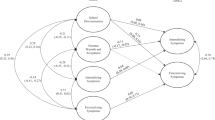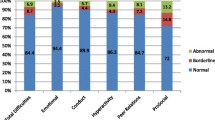Abstract
The purpose of this study was to investigate the differences in social status insecurity and self-reported relational and overt aggression based on the ethnic context of the schools, and how ethnic context moderates the associations between social status insecurity and self-reported relational and overt aggression. Participants were 405 Latinx adolescents (53% girls; M = 14.51, SD = .58). Adolescents were from one of two schools in which they were either the majority (84% Latinx population; n = 203) or the minority (10% Latinx population; n = 202). They completed questionnaires on social status insecurity and self-reported relational and overt aggression at time 1 (in 7th grade) and self-reported relational and overt aggression at time 2 (1 year later in 8th grade). The findings revealed that minority adolescents reported higher levels of social status insecurity and self-reported relational aggression at time 1 and time 2. The association between social status insecurity and time 2 self-reported relational aggression was more positive for minority adolescents. Majority adolescent status did not influence this association.

Similar content being viewed by others
References
Bellmore, A. D., Witkow, M. R., Graham, S., & Juvonen, J. (2004). Beyond the individual: the impact of ethnic context and classroom behavioral norms on victims’ adjustment. Developmental Psychology, 40(6), 1159–1172. https://doi.org/10.1037/0012-1649.40.6.1159.
DeGarmo, D. S., & Martinez, C. R. (2006). A culturally informed model of academic well-being for Latino youth: the importance of discriminatory experiences and social support. Family Relations, 55, 267–278. https://doi.org/10.1111/j.1741-3729.2006.00401.x.
Downey, G., Lebolt, A., Rincon, C., & Freitas, A. L. (1998). Rejection sensitivity and children’s interpersonal difficulties. Child Development, 69, 1074–1091.
Elliot, A. J., & Murayama, K. (2008). On the measurement of achievement goals: critique, illustration, and applications. Journal of Educational Psychology, 100(3), 613–628. https://doi.org/10.1037/0022-0663.100.3.613.
Graham, S., & Juvonen, J. (2002). Ethnicity, peer harassment, and adjustment in middle school: an exploratory study. Journal of Early Adolescence, 22, 173–199.
Graham, S., Bellmore, A. D., Nishina, A., & Juvonen, J. (2009). “It must be more”: ethnic diversity and attributions for peer victimization in middle school. Journal of Youth and Adolescence, 38, 487–499.
Guedes, M., Santos, A. J., Ribeiro, O., Freitas, M., Rubin, K. H., & Verissimo, M. (2018). Perceived attachment security to parents and peer victimization: does adolescent’s aggressive behaviour make a difference? Journal of Adolescence, 65, 196–206.
Hymel, S., Rubin, K. H., Rowden, L., & LeMare, L. (1990). Children’s peer relationships: longitudinal prediction of internalizing and externalizing problems from middle to late childhood. Child Development, 61(6), 2004–2021. https://doi.org/10.1111/j.1467.8624.1990.tb03582.x.
Juvonen, J., Nishina, A., & Graham, S. (2006). Ethnic diversity and perceptions of safety in urban middle schools. Psychological Science, 17(5), 393–400.
LaFoana, K. M., & Cillessen, A. H. N. (2002). Children’s perceptions of popular and unpopular peers: a multimethod assessment. Developmental Psychology, 38(5), 635–637. https://doi.org/10.1037/0012-1649.38.5.635.
Li, Y., & Wright, M. F. (2014). Adolescents’ social status goals: relationships to social status insecurity, aggression, and prosocial behavior. Journal of Youth and Adolescence, 43(1), 146–160. https://doi.org/10.1007/s10964-013-9939-z.
Li, Y., Wang, M., Wang, C., & Shi, J. (2010). Individualism, collectivism, and Chinese adolescents’ aggression: intracultural variations. Aggressive Behavior, 36(3), 187–194. https://doi.org/10.1002/ab.20341.
Salmivalli, C., & Peets, K. (2009). Pre-adolescents peer-relational schemas and social goals across relational contexts. Social Development, 18(4), 817–832. https://doi.org/10.1111/sode.2009.18.issue-410.1111/j.1467-9507.2008.00515.x.
Sandstrom, M. J., & Herlan, R. D. (2007). Threatened egotism or confirmed inadequacy? How children’s perceptions of social status influence aggressive behavior toward peers. Journal of Social & Clinical Psychology, 26, 240–267.
Seaton, E. K., Neblett, E. W., Cole, D. J., & Prinstein, M. J. (2013). Perceived discrimination and peer victimization among African American and Latino youth. Journal of Youth and Adolescence, 42(3), 342–350. https://doi.org/10.1007/s10964-012-9848-6.
Sijtsema, J. J., Ojanene, T., Veenstra, R., Lindenberg, S., Hawley, P. H., & Little, T. D. (2009). Forms and functions of aggression in adolescent friendship selection and influence: a longitudinal social network analysis. Social Development, 19(3), 515–534.
Smokowski, P. R., & Bacallao, M. L. (2007). Acculturation, internalizing mental health symptoms, and self-esteem: Cultural experiences of Latino adolescents in North Carolina. Child Psychiatry and Human Development, 37, 273–292. https://doi.org/10.1007/s10578-006-0035-4.
Wright, M. F. (2015). The role of the media and the cyber context in adolescents’ popularity. In P. Lorentz, D. Smahel, M. Metykova, & M. F. Wright (Eds.), Living in the digital age: self-Presentation, networking, playing, and participation in politics. Brno: Muni Press.
Author information
Authors and Affiliations
Corresponding author
Rights and permissions
About this article
Cite this article
Wright, M.F., Wachs, S. Does School Composition Moderate the Longitudinal Association Between Social Status Insecurity and Aggression Among Latinx Adolescents?. Int Journal of Bullying Prevention 1, 180–186 (2019). https://doi.org/10.1007/s42380-019-00021-x
Published:
Issue Date:
DOI: https://doi.org/10.1007/s42380-019-00021-x




